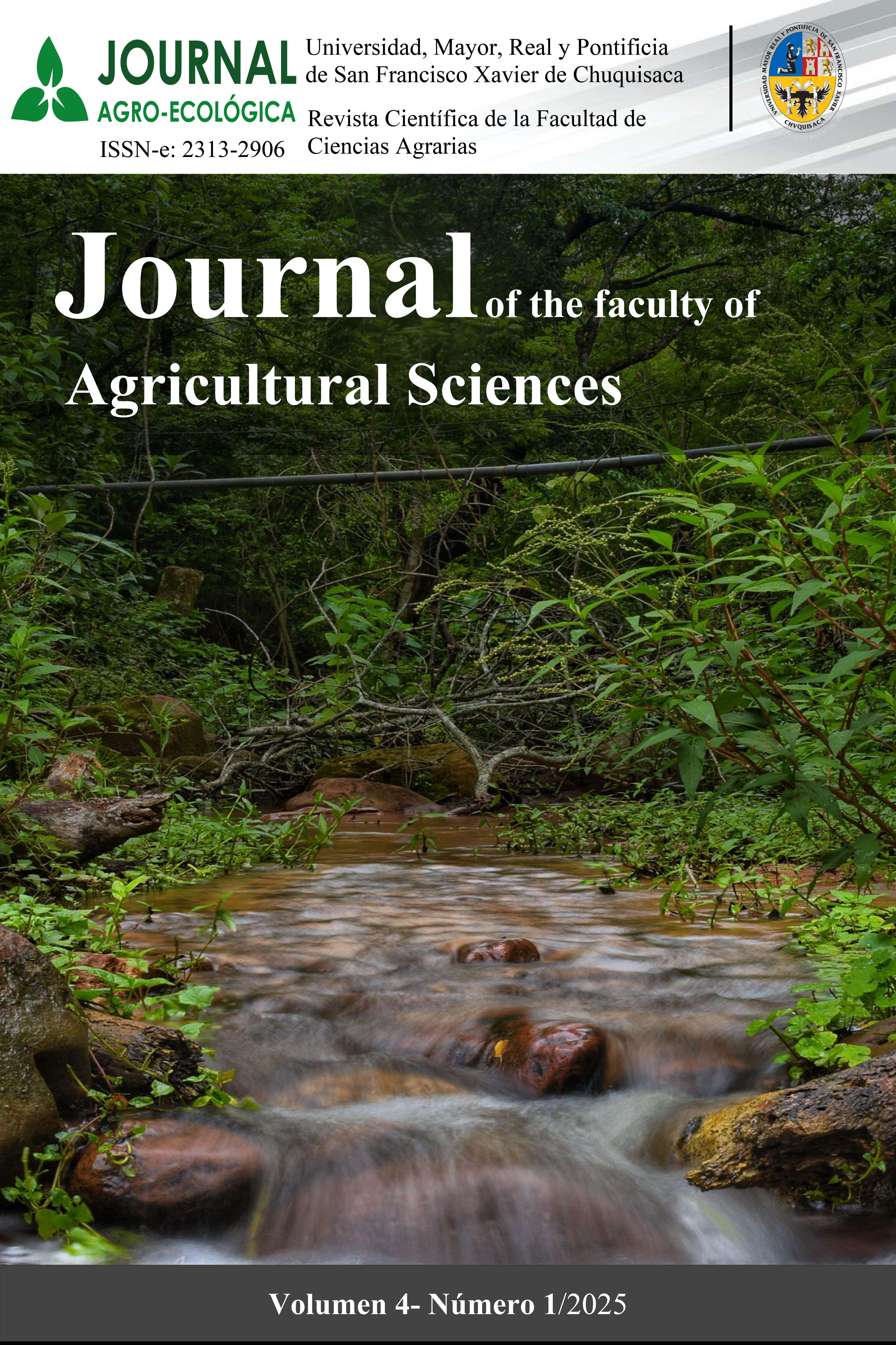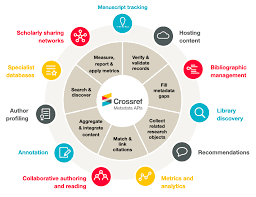Adaptación y productividad de maní (Arachis hypogea L.) en ecosistemas subandinos secos del sur de Bolivia
DOI:
https://doi.org/10.56469/rae.v4i1.1597Palabras clave:
Adaptabilidad, ecotipos, prácticas agronómicas, recursos genéticosResumen
El maní (Arachis hypogea L.) es un cultivo comercial de gran importancia en regiones tropicales y subtropicales, debido a su alto contenido de aceite, proteína, minerales y vitaminas. Se utiliza en diversas industrias, desde la alimentaria hasta la producción de fertilizantes. Sin embargo, su rendimiento y calidad se ven amenazados por factores biológicos, como enfermedades fúngicas, que afectan su crecimiento y productividad. En este contexto, el presente estudio evaluó el rendimiento agronómico de ecotipos y variedades de maní en el municipio de Padilla comunidad Pedernal, Bolivia, con el objetivo de identificar recursos genéticos con mayor potencial productivo y adaptabilidad a las condiciones agroecológicas de altura. Se evaluaron 12 tratamientos conformados por ocho c ecotipos y cuatro4 variedades comerciales. Se encontraron diferencias significativas en variables de crecimiento como la altura y el diámetro de biomasa de la planta; sin embargo, el rendimiento en grano no presentó diferencias estadísticamente significativas entre tratamientos. El tratamiento T8 registró el mayor rendimiento con 2272.52 kg/ha, mientras que T4 obtuvo el menor con 1071.31 kg/ha. Asimismo, se observaron variaciones en el porcentaje de cáscara y de granos sanos, el tratamiento T4 destacó con el mayor porcentaje de granos sanos (65%), mientras que el T5 presentó el mayor porcentaje de granos dañados (23.01%). El estudio concluyó que los ecotipos y variedades evaluadas mostraron buena adaptabilidad a las condiciones agroecológicas n en el área de estudio. Se recomienda priorizar la propagación de los ecotipos y las variedades que mostraron mayor rendimiento y sanidad, con el fin de fortalecer la estabilidad y rentabilidad de la producción local de maní. Asimismo, se destaca la importancia de profundizar en investigaciones orientadas a optimizar las prácticas agronómicas y a conservar los recursos genéticos del cultivo garantizando así su sostenibilidad en zonas de altura.
Citas
Bannayan, M., Tojo Soler, C. M., Garcia y Garcia, A., Guerna, L. C., & Hoogenboom, G. (2009). Interactive effects of elevated CO₂ and temperature on growth and development of a short and long season peanut cultivar. Climatic Change, 93(3–4), 389–406. https://doi.org/10.1007/s10584-008-9510-1
Bell, M. L., King, M. T., & Fairclough, D. L. (2014). Bias in area under the curve for longitudinal clinical trials with missing patient reported outcome data: Summary measures versus summary statistics. SAGE Open, 4(2), 1–11. https://doi.org/10.1177/2158244014534858
Chen, C. Y., Nuti, R. C., Rowland, D. L., Faircloth, W. H., Lamb, M. C., & Harvey, E. (2013). Heritability and genetic relationships for drought‐related traits in peanut. Crop Science, 53(4), 1392–1402. https://doi.org/10.2135/cropsci2012.07.0426
Eck, M. A., Murray, A. R., Ward, A. R., & Konrad, C. E. (2020). Influence of growing season temperature and precipitation anomalies on crop yield in the southeastern United States. Agricultural and Forest Meteorology, 291, 108053. https://doi.org/10.1016/j.agrformet.2020.108053
Li, L., Yang, X., Cui, S., Meng, X., Mu, G., Hou, M., He, M., Zhang, H., Liu, L., & Chen, C. Y. (2019). Construction of high-density genetic map and mapping quantitative trait loci for growth habit-related traits of peanut (Arachis hypogaea L.). Frontiers in Plant Science, 10, 745. https://doi.org/10.3389/fpls.2019.00745
Oladosu, Y., Rafii, M. Y., Abdullah, N., Magaji, U., Miah, G., Hussin, G., & Ramli, A. (2017). Genotype-by-environment interaction and yield stability of rice mutant genotypes evaluated in multiple locations of Malaysia. Acta Agriculturae Scandinavica, Section B — Soil & Plant Science, 67(7), 590–606. https://doi.org/10.1080/09064710.2017.1321138
Peeters, A., Dendoncker, N., & Jacobs, S. (2013). Chapter 22—Enhancing ecosystem services in Belgian agriculture through agroecology: A vision for a farming with a future. In P. G. Sutton, S. G. Sutton, & R. Costanza (Eds.), Ecosystem services (pp. 285–304). Elsevier. https://doi.org/10.1016/B978-0-12-419964-4.00022-6
Pereira, J., Albuquerque, M., Filho, P., Nogueira, R. J., Lima, L., & Santos, R. (2016). Assessment of drought tolerance of peanut cultivars based on physiological and yield traits in a semiarid environment. Agricultural Water Management, 166, 70–76. https://doi.org/10.1016/j.agwat.2015.12.010
Prasad, P. V. V., Boote, K. J., Allen, L. H., & Thomas, J. M. G. (2003). Super‐optimal temperatures are detrimental to peanut (Arachis hypogaea L.) reproductive processes and yield at both ambient and elevated carbon dioxide. Global Change Biology, 9(12), 1775–1787. https://doi.org/10.1046/j.1365-2486.2003.00708.x
Qin, H., Feng, S., Chen, C., Guo, Y., Knapp, S., Culbreath, A., He, G., Wang, M. L., Zhang, X., Holbrook, C. C., Ozias-Akins, P., & Guo, B. (2012). An integrated genetic linkage map of cultivated peanut (Arachis hypogaea L.) constructed from two RIL populations. Theoretical and Applied Genetics, 124(4), 653–664. https://doi.org/10.1007/s00122-011-1737-y
Sadok, W., Lopez, J. R., & Smith, K. P. (2021). Transpiration increases under high‐temperature stress: Potential mechanisms, trade‐offs and prospects for crop resilience in a warming world. Plant, Cell & Environment, 44(7), 2102–2116. https://doi.org/10.1111/pce.13970
Singh, P., Nedumaran, S., Ntare, B., Boote, K. J., Singh, N. P., Komuravelly, S., & Bantilan, M. C. S. (2014). Potential benefits of drought and heat tolerance in groundnut for adaptation to climate change in India and West Africa. Mitigation and Adaptation Strategies for Global Change, 19(5), 509–529. https://doi.org/10.1007/s11027-012-9446-7
Takhellambam, B., Srivastava, P., Lamba, J., McGehee, R., Kumar, H., & Tian, D. (2022). Temporal disaggregation of hourly precipitation under changing climate over the Southeast United States. Scientific Data, 9, 211. https://doi.org/10.1038/s41597-022-01304-7
Tardieu, F., Simonneau, T., & Muller, B. (2018). The physiological basis of drought tolerance in crop plants: A scenario‐dependent probabilistic approach. Annual Review of Plant Biology, 69, 733–759. https://doi.org/10.1146/annurev-arplant-042817-040218
Tornaghi, C. (2017). Urban agriculture in the food‐disabling city: (Re)defining urban food justice, reimagining a politics of empowerment. Antipode, 49(3), 781–801. https://doi.org/10.1111/anti.12291
Wilcox, R. R. (1986). Controlling power in a heteroscedastic ANOVA procedure. British Journal of Mathematical and Statistical Psychology, 39(1), 65–68. https://doi.org/10.1111/j.2044-8317.1986.tb00845.x




